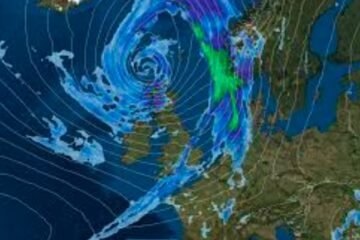Scotland has seen a sharp rise in whale and dolphin strandings over the past three decades, with numbers jumping from about 100 each year to more than 300. Researchers point to factors like noise pollution from industry, chemical waste, and climate shifts as key drivers behind this troubling trend.
This increase affects various marine mammals, including baleen whales and common dolphins, and raises concerns about ocean health. The latest study, released in 2025, highlights how these events have grown exponentially since 2010, prompting calls for urgent action to protect sea life.
The Sharp Increase in Strandings
Over the last 30 years, strandings of whales, dolphins, and porpoises on Scottish beaches have more than tripled. Data from the Scottish Marine Animal Stranding Scheme shows the annual average climbed from around 100 in the early 1990s to over 300 by 2022.
This rise is not just a small uptick. For some species, the growth has been dramatic. Common dolphins, for example, have seen strandings soar by more than 800 percent in recent years.
Experts analyzed records from 1992 to 2022. They found consistent increases across all native species in Scottish waters. Baleen whales, which filter feed on small fish and plankton, showed some of the steepest jumps.
The trend continued into 2025, with reports of multiple mass strandings. One incident involved over 150 animals washing up on shores, part of a broader wave across Europe this summer.

Possible Causes Behind the Surge
Scientists remain puzzled by the exact reasons, but several factors stand out. Noise pollution from human activities tops the list. Seismic surveys for oil, gas, and wind farms use loud airguns that can confuse whales and drive them into shallow waters.
Chemical and plastic pollution also plays a role. Toxins build up in the ocean food chain, harming marine mammals. Plastics can cause internal injuries or starvation when animals mistake them for food.
Entanglements in fishing gear add to the problem. Whales and dolphins often get caught in nets or lines, leading to exhaustion and stranding.
Climate change drives some species northward into unfamiliar Scottish waters. Warmer oceans shift fish stocks, forcing whales to follow and increasing their risk of beaching.
Boat collisions contribute too. Faster vessels in busy shipping lanes strike animals, causing fatal injuries.
- Noise from underwater surveys and construction
- Chemical pollutants and plastics in the sea
- Fishing gear entanglements
- Shifts in ocean temperatures and prey distribution
- Increased boat traffic in coastal areas
Impact on Specific Species
Common dolphins face the highest risk, with strandings up sharply. These social animals often beach in groups, leading to mass events that draw public attention.
Baleen whales, like sei and minke whales, show similar patterns. Their large size makes them prone to gear entanglements, and noise disrupts their feeding grounds.
Porpoises, smaller cousins of dolphins, have seen steady increases too. They are sensitive to pollution and often strand alone.
A recent example came in 2025 when a sei whale washed up in Arbroath. Necropsies revealed signs of noise stress and plastic ingestion.
| Species | Average Annual Strandings (1990s) | Average Annual Strandings (2020s) | Percentage Increase |
|---|---|---|---|
| Common Dolphin | 10 | 90 | 800% |
| Baleen Whales | 20 | 70 | 250% |
| Porpoises | 30 | 80 | 167% |
| Other Whales | 40 | 60 | 50% |
This table illustrates the growth based on the latest research. Numbers highlight how some groups suffer more than others.
Expert Views and Broader Concerns
Andrew Brownlow, who leads the stranding scheme, calls whales ocean sentinels. He warns that rising strandings signal deeper environmental changes. His team urges more studies to pinpoint causes.
Other experts agree. They link the issue to growing offshore wind projects. While renewable energy helps fight climate change, the construction noise could harm marine life if not managed well.
Recent events tie into global patterns. In 2025, similar strandings hit coasts in England and Ireland, often near wind farm sites. Public outcry on social media has grown, with calls to halt noisy surveys.
Logical reasoning suggests a mix of factors. As human activity expands in the sea, animals face more threats. Declining fish stocks force them into risky areas, compounding the problems.
Steps to Address the Problem
Governments and groups are stepping up. Scotland plans stricter rules on seismic surveys to reduce noise impacts. Monitoring programs track strandings in real time.
Conservation efforts focus on cleaner oceans. Bans on certain plastics and better fishing practices could cut entanglements.
Public awareness matters too. Beach cleanups and education campaigns help reduce pollution at the source.
International cooperation is key. Since whales migrate across borders, joint actions with neighboring countries could make a big difference.
Looking ahead, experts predict that without changes, strandings may keep rising. Offshore wind growth, expected to boom by 2030, adds urgency to finding solutions.
Share your thoughts on this issue in the comments below. Have you seen a stranding or want to help marine conservation? Spread the word by sharing this article to raise awareness.


















